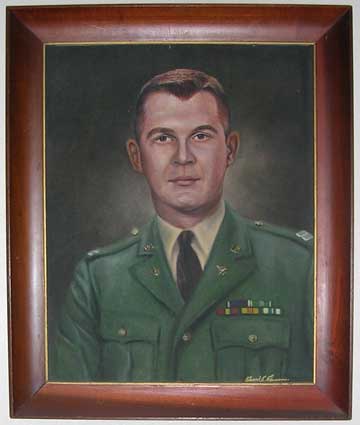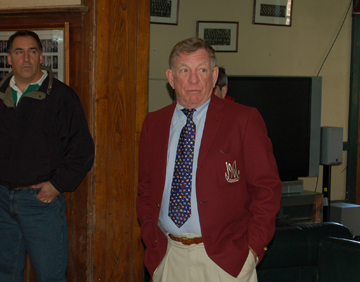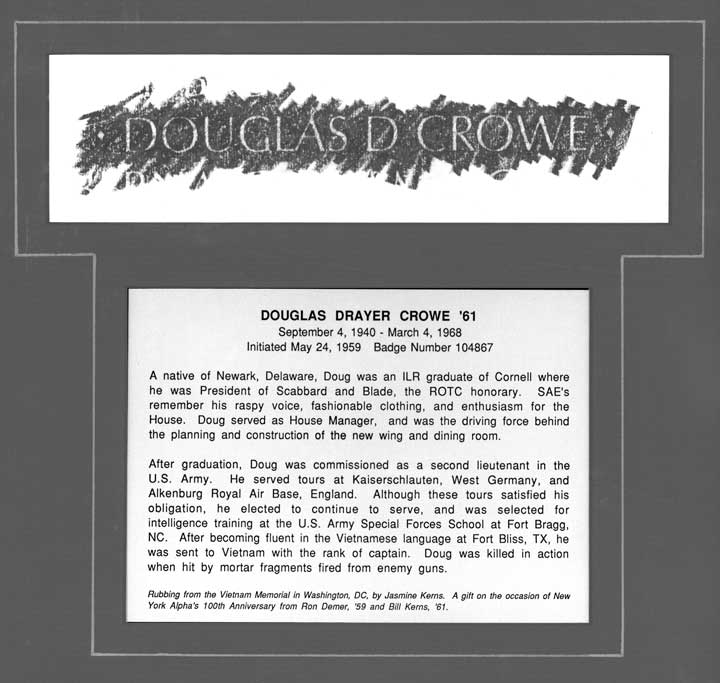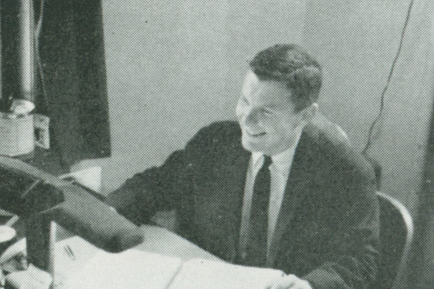Douglas Crowe ’61. Captain Crowe died in Vietnam. This bio by Ron Demer ’59, Washington Vietnam Wall rubbing by Bill Kearns’ daughter, and painting given by his parents is on display in the Hillcrest library.
by Hal Sieling ’62

Long before Cornell owned Hillcrest, there was a small alumni board that worked on various facilities issues associated primarily with operating Hillcrest on at least a break-even basis—much like any landlord would do. The group essentially represented the general alumni body, which owned the house at that time.
The first issue, I recall, was how to add revenue to house operations. That was coupled with the desire to have a dining room that was big enough for all the brothers to eat together for lunch and dinner, as well as for big party occasions.
More revenue was essential because of rising costs. Taxes had more than doubled in the past two decades. Those costs, among others, were affecting our ability to maintain the property properly.
The dining room seated just 48 brothers—a serious challenge. For years 80 to 100 were being served for some meals, so people were spread all through the Great Hall. It was logistically difficult, to say the least.
The living situation was even more acute. Capacity was just 38, and an average sophomore class had 30 brothers. This situation was forcing most juniors and many seniors to live out, which had an impact on chapter unity and leadership—a problem fraternities still struggle with today.
SAE was not unique. Fraternities as a whole were growing as the student body expanded. Fraternity membership was in full bloom.
At the time, one young alumnus and new board member, Doug Crowe ’61, was at the forefront of working with longtime Chapter Adviser Fairbairn “Gilk” Gilkeson to solve these problems. Doug was determined. His first love was SAE, and his second was Cornell. He would do anything for either. He was not a particularly good student, so he was hanging around Hillcrest for a couple of years after his normal graduation date picking up needed credits. He also faced an Army obligation upon graduation.
The solution to these problems was the new wing: new rooms for more actives to live in and a new dining room that seated 125. With a mortgage from a local bank in hand, Doug and Gilk struck a deal with the alumni board. All seemed pleased, and no one objected to their plan.
Both panned and praised over the years, the wing became a reality. The addition was a necessity, although the timing could not have been worse for reasons not unique to SAE.
Alumni contributions to pay off the debt did not materialize for a number of obvious—and some not-so-obvious—reasons. The first campaign itself was a total bust; it never really got off the ground.
As the Vietnam War dragged on, fraternity life was taking a hit. Even in the aftermath of the war in the late ’70s, fraternity membership continued to decline. Worse still, some actives were not paying their house bills. Again, SAE was no exception. The debt continued to grow, and until the very late ’70s, there was no solution in view.
What all of this shows is that Doug Crowe and the other board members at the time had very good intentions, but those backfired on them through circumstances that they could neither anticipate nor prevent. It was not long into this horrible span of time that all of the board members from this era resigned and no replacements stepped forward. Reminds me of the old saying ”No good deed deserves to go unpunished”!
As fate would have it, Doug decided to continue his Army career past the normal tour and was shipped to Vietnam, where he lost his life. We don’t know much about his life after Hillcrest beyond this piece here on our website.
Captain Douglas D. Crowe’s name—and those of more than 58,000 other young American soldiers—can be found on the Vietnam Veterans Memorial Wall in Washington. A copy of his rubbing is on display in our library at Hillcrest, along with a nice painting of Doug in his uniform and the small piece about his Army career.



